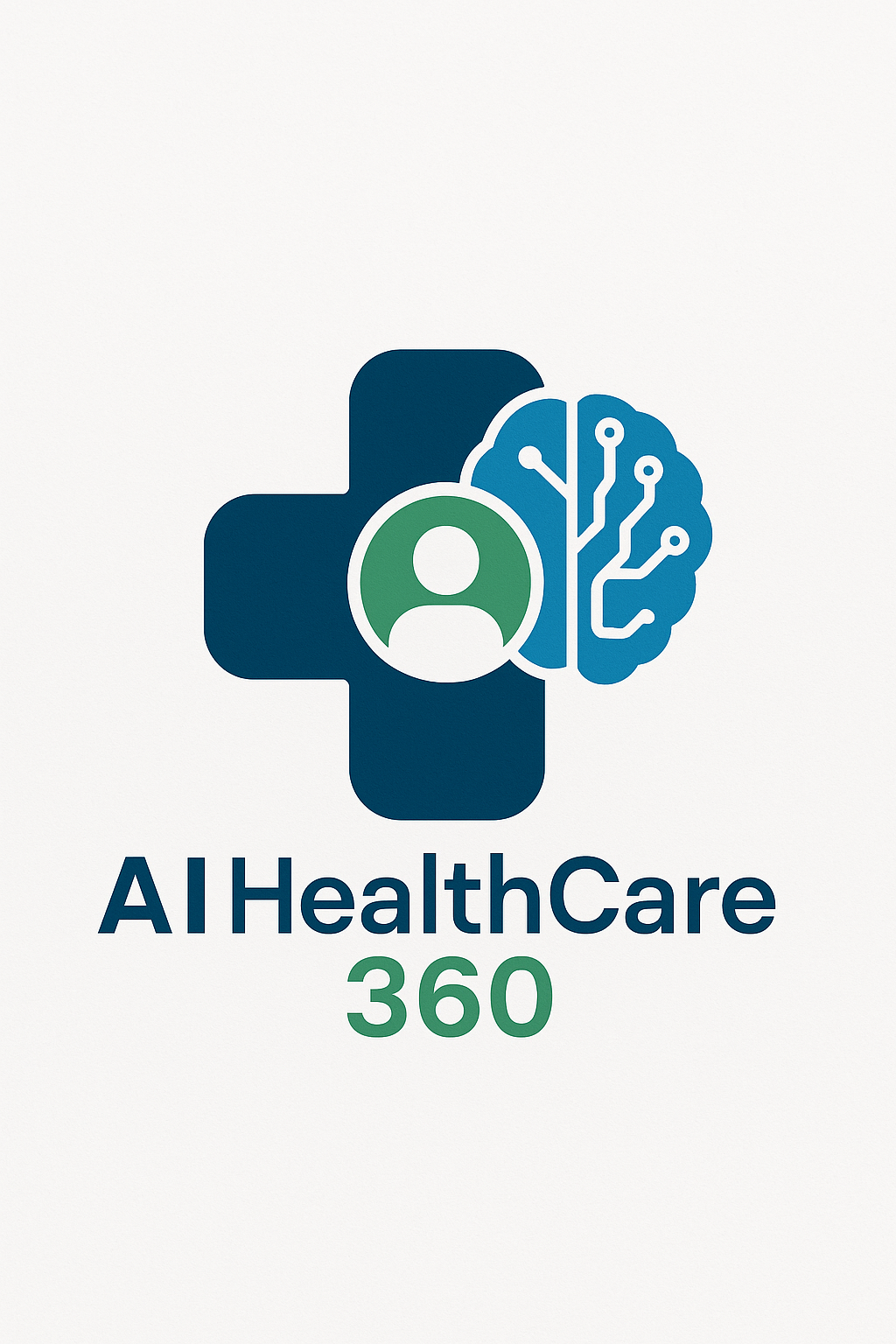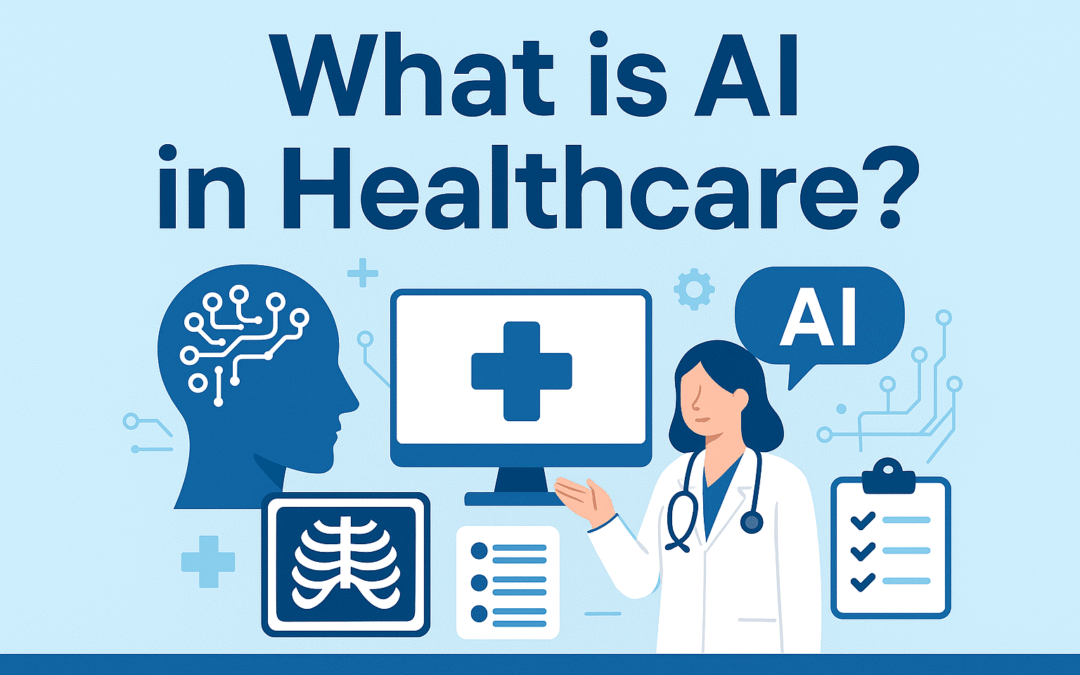Introduction
Healthcare is changing rapidly. Doctors and nurses are under pressure to see more patients, reduce costs, and still give personal care. This is where artificial intelligence (AI) comes in. AI in healthcare means using smart computer systems to analyze data, support decisions, and automate routine tasks so that healthcare staff can focus more on patients.
What is AI in Healthcare (in simple words)?
AI in healthcare is the use of computers that can “think and learn” from data. Just like Netflix recommends a movie by studying your choices, healthcare AI can:
-
Read medical scans and highlight problems.
-
Listen and write doctors’ notes automatically.
-
Predict which patients might need extra care.
It’s not about replacing doctors. Instead, it’s about giving them tools to make better and faster decisions (the AMA calls this “augmented intelligence”—AI that supports clinicians, not replaces them.
How does AI work in healthcare?
AI learns from data — electronic health records, lab reports, X-rays, even voice notes. The main types are:
-
Machine Learning: Finds patterns (e.g., predicting who is at risk for diabetes).
-
Computer Vision: Looks at images like MRIs or X-rays.
-
Natural Language Processing (NLP): Understands and writes human language (e.g., clinical notes, chatbots).
-
Generative AI (like ChatGPT): Creates text, summaries, or even drafts of medical reports.
Examples of AI in Action
1. Medical Imaging
Doctors spend a lot of time looking at X-rays, MRIs, and CT scans. AI can act like an “assistant” that points out areas of concern, such as a small tumor or a fracture, so the doctor doesn’t miss it. A well-known US example is Viz.ai, which is FDA-cleared and used in thousands of American hospitals to quickly detect strokes from CT scans and alert specialists in real time. This helps doctors catch serious conditions earlier and treat patients faster.
2. AI Scribes
Doctors often spend hours every day typing notes after seeing patients. This paperwork takes time away from care and adds stress. AI scribes solve this problem by listening during the appointment and automatically drafting the doctor’s notes.
This means doctors can focus on listening to their patients instead of typing on a computer. Large systems report thousands of hours saved—for example, The Permanente Medical Group logged ~15,791 hours saved in one year after 2.5 million uses.
3. Hospital Operations
Hospitals are busy places. Sometimes the emergency room is overcrowded, or appointments are missed because patients don’t show up. AI can look at past data and predict when busy times will happen, or which patients might miss their appointment.
For example, Medozai is an AI platform that helps clinics and hospitals with scheduling, intake, and task management, reducing workload and patient wait times. Other well-known hospital AI platforms include Qventus, which predicts patient flow and supports inpatient throughput , and LeanTaaS, which helps manage operating room schedules. These tools allow hospitals to schedule staff better and reduce waiting times.
4. Virtual Assistants
Many patients have questions outside of visits — like “When should I take this medicine?” or “Do I need to fast before my test?” AI chatbots can answer common questions anytime of day. They don’t replace a nurse or doctor, but they reduce phone calls and help patients feel supported between visits.
Benefits of AI in Healthcare
1. Faster Results
AI can check scans or test results very quickly, often in minutes. This helps doctors make decisions faster, which can mean starting treatment earlier.
2. More Time with Patients
By handling routine paperwork, AI gives doctors back precious time. Instead of staying late to finish notes, they can spend that time talking to patients or resting.
3. Better Access to Care
In small towns or rural areas, there may not be enough specialists. Imaging AI and autonomous screening tools allow earlier checks closer to home.
4. Lower Costs Over Time
Catching diseases early means treatments are simpler and less expensive. AI can also help hospitals run more smoothly, which reduces wasted time and resources.
5. Consistency
Doctors may have different opinions, but AI gives the same analysis every time. This consistency can reduce mistakes and make care more reliable.
Pros and Cons of AI in Healthcare
Pros (The Good Side)
- Helps Doctors, Not Replaces Them: AI is like an assistant, making doctors’ work easier
- Saves Time: Less paperwork and faster test reading.
- Better Access: Even small clinics can use AI tools to catch diseases.
- Improves Accuracy: AI can spot details that humans might miss (e.g., stroke triage tools like Viz.ai).
- 24/7 Availability: AI tools don’t get tired — they can run checks anytime.
Cons (The Caution Side)
- Not Perfect: AI can make mistakes, so doctors must double-check (WHO urges transparency and oversight for new models).
- Bias in Data: If AI is trained on limited data, it may not work as well for all patient groups (well‑known example of bias in a U.S. risk algorithm).
- Privacy Concerns: Patient information must be kept safe and secure (HIPAA Privacy Rule; HIPAA Security Rule).
- Cost of Setup: Hospitals may need to spend money on equipment and training (vendor case studies detail ROI and ramp-up: LeanTaaS, Qventus).
- Trust Issues: Some patients and doctors may feel unsure about trusting AI decisions (hence clear labeling and human‑in‑the‑loop are important).
Future of AI in Healthcare
Experts believe AI will soon:
- Personalize treatment plans for each patient.
- Speed up drug discovery.
- Help manage population health by spotting outbreaks early.
But safe growth requires strong rules, transparency, and human oversight (see WHO guidance on large multimodal models: WHO, 2024 and the FDA’s AI/ML resources: overview, AI/ML‑enabled devices list).
Conclusion
AI in healthcare is no longer just an experiment — it is already changing how hospitals and clinics work in the United States and around the world. From reading scans faster to reducing paperwork with AI scribes, these tools are helping doctors and nurses spend more time with patients and less time on routine tasks. Hospitals are using AI to cut waiting times, improve accuracy, and make care more consistent.
At the same time, AI is not perfect. It needs strong human oversight, reliable data, and careful attention to privacy and fairness. When used responsibly, AI is a powerful assistant — not a replacement — for healthcare professionals.
The future will bring even more growth: personalized treatments, faster drug discovery, and smarter hospital systems. For healthcare leaders, the key is to embrace AI step by step, focusing on safe, ethical, and patient-centered use.
FAQs AI in Healthcare
1. Will AI replace doctors?
No. The American Medical Association frames it as “augmented intelligence,” meaning AI supports clinical work rather than replaces it
2. Is AI in healthcare safe?
Yes, when approved by regulators like the FDA. However, AI must always be used with human oversight to avoid mistakes.
3. Do hospitals in the US already use AI?
Yes. Tools like Viz.ai, Nuance DAX Copilot, and Buoy Health are already in use across American hospitals and clinics.
4. How does AI affect patient privacy?
Hospitals must follow HIPAA laws, ensuring patient data is protected. AI systems need secure data handling to keep information private.
5. Is AI affordable for small clinics?
Some AI tools are becoming more affordable and available as cloud-based services, making them easier for smaller clinics to adopt.
6. Are AI scribes safe and private?
AI scribes still require clinician review for accuracy. Privacy and security are governed in the U.S. by HIPAA’s Privacy Rule and Security Rule.

